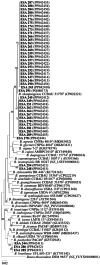High Temperatures and Bacillus Inoculation Affect the Diversity of Bradyrhizobia in Cowpea Root Nodules
- PMID: 40391659
- PMCID: PMC12406091
- DOI: 10.1002/jobm.70058
High Temperatures and Bacillus Inoculation Affect the Diversity of Bradyrhizobia in Cowpea Root Nodules
Abstract
Future climatic scenario predictions indicate a substantial temperature increase, reducing crop production worldwide and demanding the development of adaptations in agriculture. This study aimed to assess the impact of high temperatures and amendments with Bacillus on nodulating bradyrhizobia. Two cowpea genotypes were evaluated at low (min = 20.0°C, max = 33.0°C) and high-temperature regimes (min = 24.8 C, max = 37.8°C). Plants were also inoculated with Bacillus sp. ESA 402, a plant growth-promoting bacterium. The molecular diversity of the bradyrhizobia isolated from cowpea nodules and plant growth was assessed. High temperatures reduced nodulation of the BRS Itaim cowpea genotype. One hundred and eighty-six were genotyped, clustering the collection into 45 groups. The high temperatures reduced the number of groups, but this negative influence was diminished by Bacillus inoculation. Alpha diversity showed little impact on the experimental interactions. However, this influence was evident for all factors and the interaction of the three factors when beta diversity was assessed. 16S rRNA and constitutive gene sequences identified all strains as Bradyrhizobium spp. mainly within the B. japonicum supercluster. Cowpea-Bradyrhizobium association diversity is multifactorial under different temperature regimes, as is the presence or absence of the plant-growth-promoting bacteria Bacillus sp. ESA 402.
Keywords: Bacillus sp; Bradyrhizobium; climate change; heat stress; inoculant.
© 2025 The Author(s). Journal of Basic Microbiology published by Wiley‐VCH GmbH.
Figures







Similar articles
-
Unveiling remarkable bacterial diversity trapped by cowpea (Vigna unguiculata) nodules inoculated with soils from indigenous lands in Central-Western Brazil.Braz J Microbiol. 2025 Mar;56(1):545-562. doi: 10.1007/s42770-025-01622-z. Epub 2025 Jan 23. Braz J Microbiol. 2025. PMID: 39847210
-
Bradyrhizobium tunisiense sp. nov., a novel rhizobial species isolated from Acacia saligna nodules.Int J Syst Evol Microbiol. 2025 Jun;75(6):006807. doi: 10.1099/ijsem.0.006807. Int J Syst Evol Microbiol. 2025. PMID: 40536800 Free PMC article.
-
Spontaneously Produced Lysogenic Phages Are an Important Component of the Soybean Bradyrhizobium Mobilome.mBio. 2023 Apr 25;14(2):e0029523. doi: 10.1128/mbio.00295-23. Epub 2023 Apr 5. mBio. 2023. PMID: 37017542 Free PMC article.
-
Direct-acting antivirals for chronic hepatitis C.Cochrane Database Syst Rev. 2017 Sep 18;9(9):CD012143. doi: 10.1002/14651858.CD012143.pub3. Cochrane Database Syst Rev. 2017. PMID: 28922704 Free PMC article.
-
Systemic pharmacological treatments for chronic plaque psoriasis: a network meta-analysis.Cochrane Database Syst Rev. 2021 Apr 19;4(4):CD011535. doi: 10.1002/14651858.CD011535.pub4. Cochrane Database Syst Rev. 2021. Update in: Cochrane Database Syst Rev. 2022 May 23;5:CD011535. doi: 10.1002/14651858.CD011535.pub5. PMID: 33871055 Free PMC article. Updated.
References
-
- Angelotti F., Fernandes‐Júnior P. I., and de Sá I. B., “Mudanças Climáticas no Semiárido Brasileiro: Medidas de Mitigação e Adaptação,” Revista Brasileira de Geografia 06 (2011): 1275–1291.
-
- Angelotti F., Oliveira A. R., de Giongo V., Barros J. R. A., and Guimarães M. J. M., “Sustainable Agriculture as an Adaptation Measure for Araripe Plaster Pole.” in Public Policies for Adapting Agriculture to Climate Change in Semi‐Arid Northeast Brazil, eds. SABOURIN E., OLIVEIRA L. M. R., GOULET F. and MARTINS E. S. (Rio de Janeiro: E‐papers, 2022).
-
- Santos C. A. F., “Melhoramento do feijão‐caupi para temperaturas moderadas e elevadas no Vale do São Francisco,” Revista Brasileira de Geografia 6 (2011): 1151–1162.
-
- Melo A. S., Melo Y. L., Lacerda C. F., Viégas P. R. A., Ferraz R. L. S., and Gheyi H. R., “Water Restriction in Cowpea Plants [Vigna unguiculata (L.) Walp.]: Metabolic Changes and Tolerance Induction,” Revista Brasileira de Engenharia Agrícola e Ambiental 26 (2022): 190–197.
-
- Carvalho M., Lino‐Neto T., Rosa E., and Carnide V., “Cowpea: A Legume Crop for a Challenging Environment,” Journal of the Science of Food and Agriculture 97 (2017): 4273–4284. - PubMed
MeSH terms
Substances
LinkOut - more resources
Full Text Sources
Miscellaneous

